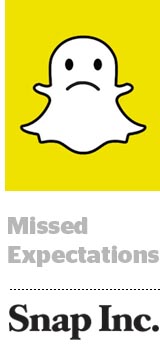
Snap said during its Q3 earnings call Tuesday that pricing pressure caused its CPMs to sink 60% year-over-year and 20% sequentially, as more advertisers switched from direct buys to using its self-serve programmatic platform.
“The auction transition continued to impact Snap ad pricing during the quarter,” said chief financial officer Drew Vollero. “Most of [the decline] was driven by the shift from reserved inventory on rate card prices to non-reserved inventory.”
Eighty percent of impressions on Snap were delivered programmatically last quarter, up 60% sequentially and 400% year over year. The number of advertisers buying self-serve increased five-fold since Q2.
But the switch to auction-based pricing “has made it difficult to reach revenue,” said CEO Evan Spiegel.
“The substantial decline in average CPMs during the transition to the auction means the majority of revenue growth has come from new advertisers,” he said.
Snap once again came in below analyst expectations for the quarter. Revenue grew 62% to $207.9 million year over year. Analysts expected revenue to grow 85% to $236.9 million. Ad revenue made up the majority of total revenue at $204 million, increasing 59% YoY and 16% sequentially.
Daily active users (DAUs) grew 17% year over year from 153 million to 178 million. DAUs increased by 4.5 million in the third quarter, growing 3% from 173 million in Q2. Analysts expected Snap to add 8 million users last quarter.
Average revenue per user (ARPU) grew 39% year over year to $1.17. That’s up 12% from Q2, when ARPU was $1.05. By comparison, Facebook’s ARPU for Q3 was $21.20.
Stocks were down 17% in after-hours trading at $15 per share.
Back To Growth
Snap expects to grow CPMs – and, in turn, revenue – by onboarding more advertisers to its self-serve platform because as buyers bid on the same inventory, it will drive prices back up. In Q3, auctions with multiple bidders resulted in 40% higher CPMs than non-contested auctions.
“The transition to self-serve is an important part of scaling our business,” said chief strategy officer Imran Khan. “While this diminishes revenue in the short term, it builds the foundation for long term, scalable revenue.”
Investing in a self-serve offer will make Snapchat more appealing for small businesses and direct response advertisers to buy. Snap more than tripled revenue from SMBs on its platform in Q3, Khan said.
New tools like Snap’s measurement pixel, released in alpha last week, will attract more small businesses and direct response advertisers with its ability to close the loop on campaigns. Snap will continue to leverage Placed, which measured more than 300 campaigns for advertisers last quarter, to bring better measurement solutions to these buyers.
“To unlock the true potential of this segment, we need to invest in first party measurement solutions,” Khan said.
As Snap grows its self-serve platform, its direct salesforce will transition into a consulting role that helps clients optimize spend and make effective creative.
“Advertisers need to understand our platform, what works and how to win on Snap,” Khan said. “As we make our buying platform more automated, our sales force transitions from making orders to become more of a consultant for clients.”
Still, Snap has work to do on getting CPMs back up and growing its user base.
“We recognize the areas we need to invest in and we’re acting quickly,” Khan said.
Not All Sour Grapes
While Snap is struggling to grow revenue, it saw some success with its ad business last quarter. The platform sold 15% more sponsored lenses since it launched audience lenses in Q2, which allows advertisers to create sponsored lenses for a targeted audience at a lower entry point.
And despite slow user growth, Snap is still extremely popular with a young demographic. The platform reaches 70% of the 13-34-year-olds in the US, UK, France and Australia. Over 60% of DAUs create Snaps every day and overall time spent on the platform is growing, Spiegel said, but declined to break out specific numbers.
In order to gain traction with older demographics, Snap is redesigning its platform to make content more personalized and easier to find.
“There’s a strong likelihood that the redesign of our app will be disruptive to our business in the short term and we don’t know how the behavior of our community will change,” Spiegel warned.
This post was syndicated from Ad Exchanger.

More Stories
New pDOOH packs from MediaWorks deliver instant reach
Week of April 7 Morning News Ratings: Today Celebrates 87 Weeks at the Top of the Demo
Pead promotes talent from within